
Note: This page is an archive, retained for the convenience of anyone who has bookmarked it in the past. The updated, corrected, and expanded version is now our "Autoharp Factory Chord Setups" article at HarpersGuild.com
| Please Read: How to Help Our Site at No Cost to You - Some of our articles contain recommendations for products we like and vendors we personally trust. Some of those vendors may pay us a very small commission if you click on a link and buy their products. This costs you nothing at all and helps offset the costs of what we do. So if we point you to something you decide to buy later, please make certain you come back through our site and click on the link directly. Thanks. |
| This Site is a Cookie-Free Zone - Except for discussion forums that you have to expressly register for, none of our pages use cookies of any kind. Some of the vendors we link to do, but that won't affect you unless you click on a link to their pages. Your continued use of this page indicates that you agree to our policy. For details, click here. |



|
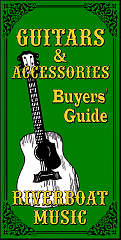
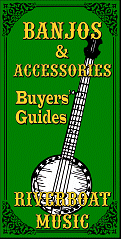
Autoharp Factory Tunings
Each of the four most popular factory autoharp configurations has historically been set up to play in a certain number of keys (based on a simple 3-chord song). Unfortunately for fans of traditional Folk, Old-Timey, and Fiddle music, the earliest autoharps were invented when brass bands were still in vogue, and as they expanded the number of keys they would support, they added more trumpet-friendly keys (with flats) than they added guitar-friendly keys (with sharps).- 12-chord autoharps (no longer made) could play songs in F, C, and G.
- Standard 15-chord autoharps add the ability to play songs in Bb, F, C, G, and D.
- Standard 21-chord autoharps can play songs in Eb, Bb, F, C, G, D, and A.
Why Song Keys Don't Tell the Whole Story
Many, many songs, especially Folk and Country songs can get by with just three chords, say G, C, and D7 or D, G, and A7. But there are many other songs that need extra chords. And that's where those extra chord bars come in. A song in the key of F, for example, will almost always use Bb and C (or C7). But it may also need Am, Dm, G, Gm, and G7, especially if it's a Tin-Pan Alley song, Jazz standard, "Pop" song, "Worship" song, and many Country songs. You might consider those chords "supplementary" in the key of F. If you're playing a standard OS or Chromaharp autoharp, you'll almost always have all the "supplementary" chords you need to play in F (or in Bb and Eb, if you have a 21-key harp).Now, say you're moving from your Ragtime Banjo Society gig to a Folk, Bluegrass, Celtic, or Country gig, and your new bandmates want to do the same song in A that you're used to playing in F. You'll discover in a heartbeat that you don't have the chords you need, which may include, not only D and E7 but also A, Em, and B7 (present on a 21-chorder, but not on a 15-chorder) as well as E, Bm, F#m and maybe even C#m.
So it's easy to say that you can play songs in the key of A on a 21-chord autoharp, but that isn't the same as saying that the instrument is SUITED for playing in the key of A, unless you're committed to playing only the simplest possible tunes.
Sharp-Friendly Variants
Oscar Schmidt and Chromaharp haven't been entirely deaf to the pleas of Folk-based artists.
- In the 1970s, two variations on the 15-chord autoharp were built that made it possible to play three-chord songs in A, though they still left out F#m and Bm in favor of Bb and C7, two chords that are far less useful in Folk-based genres. (More information on these variants is provided below.)
- One current 21-chord Oscar Schmidt model, the Americana (#OS110 21AE), adds chords like F#m and Bm that make playing complex songs in D possible (more below). But the Americana isn't cheap, and a lot of folks with older harps would like to be able to play in folk keys. For that reason, there's quite a market in aftermarket felts and even chord bars for folks wanting to tweak which chords they can play on standard instruments.
Again, autoharps (especially 21-chord Oscar Schmidts) can be reconfigured to play in sharp keys or for other reasons, but before you buy the next used autoharp you see, take some time to determine what model will best serve your purpose.
Starting With the Basics
I started to write another article before I wrote this one, about reconfiguring autoharps to play your favorite keys. Then I realized that much of what I "knew" about autoharps was misguided, to say the least, by only being really exposed to a handful of instruments. I also figured that telling folks what they could change their autoharps TO without being clear what they were changing them FROM would be less than helpful for folks who are wondering if, say, that $100 autoharp on Craigs List would be a good starting point.
 Note: If you don't already own an autoharp, and are looking to buy one, consider bypassing the old "A" style - they were made for playing on the lap, not held across the chest as is the modern usage. Bob Lewis has a useful explanation here The "A Reissue" is okay, though - its chord bars are placed for upright playing.
Note: If you don't already own an autoharp, and are looking to buy one, consider bypassing the old "A" style - they were made for playing on the lap, not held across the chest as is the modern usage. Bob Lewis has a useful explanation here The "A Reissue" is okay, though - its chord bars are placed for upright playing.
Standard Factory Layouts
Though there have been some custom instruments, and there are other brands that don't necessarily conform, the factory layouts you'll see most often on most Oscar Schmidt and Chromaharp autoharps are described below.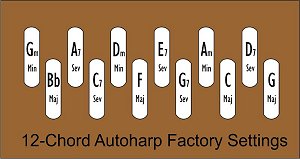
12-Chord
A "store-bought" 12-button autoharp (an early model not made today) typically includes buttons for Bb, F, C, C7, G, G7, Gm, D7, Dm, A7, Am, and E7 (chords are listed in circle-of-fiths order). So you see that, as equipped, a 12-button autoharp can play typical songs in F, C, and G. If you have a guitar-playing friend who plays Folk or Country songs in D, A, or E, buy him a capo.You probably won't be playing or reconfiguring a 12-chord autoharp anyway. Most of them were made for laptop playing (not upright as autoharps are typically played today). But they're worth discussing, since the original 12 chords were retained in the same sequence on the 15-chord version.
15-Chord
 |
 |
 Bb, F, C, G, and D, which is an improvement, but still neglects A and E.
Bb, F, C, G, and D, which is an improvement, but still neglects A and E.
Note: That this arrangement keeps the "basic" 12 keys the same, which puts the D chord almost out of reach of the G chord that would typically be played in the key of D. Apparently Oscar Schmidt company imagined they were marketing this to their original base, who might reject a more sensible overall setup.
Moreover, as a Folk singer who plays a lot of songs in D, I'm used to having access to Em, Bm, and F#m on guitar, banjo, and mandolin. So complex folk-style songs like "City of New Orleans" are still out of the question.
A Note About 15-Chorders as First Instruments - Millions of 15-chord Oscar Schmidts and Chromaharps have been built over they years and quite a few come on the used market in something close to playable condition. They are almost always much cheaper than used 21-chorders in similar condition. The new ones tend to be about 25% cheaper than the new 21-chord versions.
So both used and new 15-chorders tempt folks who don't want to spend a lot of money on an instrument that they're just trying out. If you're buying used and can get a playable 15-chorder for a very good price, you'll learn a lot from it. (BTW, these days, Chromaharp 15-chorders seem to have better quality control than Oscar Schmidt 15-chorders, so don't let the Chromaharp brand put you off.)
That said, if you want to buy new, the price difference between a 15-chorder and a 21-chorder isn't as great. You may be better off saving a little longer and starting with a 21-chord version. That said, a lot of folks who start out on a 15-chorder and go to a 21-chorder later, find other uses for their first harp, like making it diatonic.
Trying to be Folk- (and Bluegrass-) Friendly During the Folk Revival, the rise of Bluegrass, and the mainstreaming of Country music, autoharp players clamored for more guitar-friendly chords on their instruments. Both Chromaharp and Oscar Schmidt heard them, sort of. They produced 15-chorders that gave you E and A chords by sacrificing the Eb and F7, two chords you almost never need in Folk, Bluegrass, or Country. But they didn't go far enough.
 | 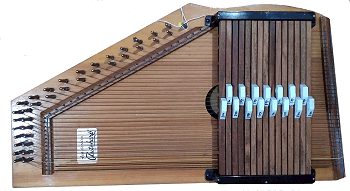 |
 The O.S. Appalachian and Chromaharp "Bluegrass" models shown above give you E and A chords by sacrificing the Eb and F7 chords. (The instrument includes Bb, F, C, C7, G, G7, Gm, D, D7, Dm, A, A7, Am, E, and E7.) So you can play simple songs in F, C, G, D, and A.
The O.S. Appalachian and Chromaharp "Bluegrass" models shown above give you E and A chords by sacrificing the Eb and F7 chords. (The instrument includes Bb, F, C, C7, G, G7, Gm, D, D7, Dm, A, A7, Am, E, and E7.) So you can play simple songs in F, C, G, D, and A.
So if you are playing with a fiddler who loves doing old-time fiddle tunes, you can play along (and trust, me, you'll never miss Eb or F7 in that environment).
On the other hand, if you're playing with a guitarist who wants to do anything by Paul Simon, James Taylor, Judy Collins, Gordon Lightfoot, Steve Goodman, Noel Stookey, Dolly Parton, Garth Brooks, or most other Folk, Folk-Rock, or Country artists, you'll probably be missing chords you need, like Em, Bm, and F#m to name a couple.
Note: Like the standard 15-button autoharp, this arrangement keeps the "basic" 12 keys the same, even though playing in D is still awkward, and the reach from A to E7 is "dicey." That said, as long as you don't disassemble your autoharp over shag carpet, there is no compelling reason you can't move the keys around to make your favorite keys easier to play.
Note about Oscar Schmidt "Appalachian": As shown above, the 15-chord Oscar Schmidt "Appalachian," made in the 1970s, looked pretty much like their other 15-chorders, but used the same layout described above (with A, D, and E in the left three buttons). Aside from looking at the buttons (which you can't read in most eBay or Craigs List ads), one way to tell is that the word Appalachian appears in a box over the Autoharp logo. 
Oscar Schmidt briefly carried this chord arrangement into their "Model B" line (the more streamlined versions that emerged in the late 1960s.) However later versions of the 15-chord Appalachian, including the OS45B, reverted to the standard 15-chord Autoharp setup.
All 21-chord "Appalachians" follow the standard 21-chord setup (below). Some were cooler looking, with a flower-shaped tone hole, but - despite the cool looks and manufacturer promises - were no more "suited for Bluegrass" than any other 21-chorder in their lineup. (Note: The early 21-chord flower-designed "Appalachian" was replaced with a round-holed version, and the word "Appalachian" was removed, but the model number, OS45C remained the same.)
Sadly, the Chromaharp Bluegrass model and the early Oscar Schmidt "Appalachian" fell far short of giving Folk, Bluegrass, and Country musicians what they needed (more chords to support playing in sharps). The few that remain are more-or-less oddities, unless some inventive person has reconfigured them with useful chords.
I have owned one of each, and I did reconfigure my Chromaharp Bluegrass. I converted E7 to Em (a much more useful chord in keys like C, G, and D.) I also rearranged the chord bars to bring D and G closer to each other. For a description of that project, click here.
21-Chorder
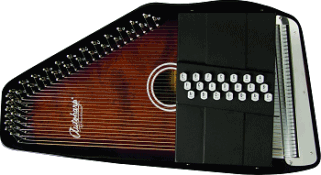 |
 |
 A standard 21-button" Oscar Schmidt or Chromaharp autoharp's "factory layout" chord array (given in Circle-of-Fifths) is Ab, Eb, Bb, Bb7, F, F7, C, C7, Cm, G, G7, Gm, D, D7, Dm, A, A7, Am, E7, Em, and B7. Which mean you can play basic three-chord songs in Eb, Bb, F, C, G, D, and A. If you're playing in keys like Bb, you have a lot of extra chords to use for fancy arrangements. In addition, the chord arrangement makes sense - with most of the buttons being arranged in a "circle of fifths" sequence, so when someone decides to pitch a song in C instead of D, all you have to do is move your left hand over a couple buttons.
A standard 21-button" Oscar Schmidt or Chromaharp autoharp's "factory layout" chord array (given in Circle-of-Fifths) is Ab, Eb, Bb, Bb7, F, F7, C, C7, Cm, G, G7, Gm, D, D7, Dm, A, A7, Am, E7, Em, and B7. Which mean you can play basic three-chord songs in Eb, Bb, F, C, G, D, and A. If you're playing in keys like Bb, you have a lot of extra chords to use for fancy arrangements. In addition, the chord arrangement makes sense - with most of the buttons being arranged in a "circle of fifths" sequence, so when someone decides to pitch a song in C instead of D, all you have to do is move your left hand over a couple buttons.
Not "Ideal for Bluegrass" - Still, the 21-chord version isn't much more helpful to a player of Folk, Bluegrass, Celtic, or country than the "Bluegrass" 15-chord model. In fact the 21-chord "Appalachian" model has the standard 21-chord setup. The Oscar Schmidt materials say it's "Ideal for Bluegrass." But the only differences between this and their entry-level OS-21 harps are cosmetic.
 Trying More Successfully to be Folk-Friendly
Trying More Successfully to be Folk-Friendly
The "Americana" 21-chord model OS110 21AE also comes with E major, B minor, and F# minor chords. This makes it pretty much a full-featured key-of-D harp with a built-in pickup, and fine tuners. The "downside" of this setup is that it swaps the position of the major and seventh chords, so if you're used to a standard 21-chord autoharp, you'll have to retrain your left hand a little.
Note: As far as I can tell, Oscar Schmidt adopted this setup for the Americana because it is the favorite setup of autoharp player Bryan Bowers and his disciples. Custom autoharp maker d'Aigle also favors this setup. And, frankly, the more I play autoharp, I am coming to prefer it. Once you're used to it, the chords you're most likely to need for songs in the key of F, C, G, D, or A are all in the same relative position.
 Note about Bm, F#m, and E: If you already have a 21-chord Oscar Schmidt autoharp, and you're lusting after the E, Bm, and F#m buttons on this 'harp, you might be glad to know that Elderly Music sells those chord bars separately for about $10 apiece. What's preventing you from rechording your 21-button OS? About $30 plus shipping and an hour or so of work. Or you can do some research, buy some felt, and rework 3 to 5 of the bars yourself, depending on the final configuration you're after. Our article Making Your Autoharp Folk-Friendly contains some tips.
Note about Bm, F#m, and E: If you already have a 21-chord Oscar Schmidt autoharp, and you're lusting after the E, Bm, and F#m buttons on this 'harp, you might be glad to know that Elderly Music sells those chord bars separately for about $10 apiece. What's preventing you from rechording your 21-button OS? About $30 plus shipping and an hour or so of work. Or you can do some research, buy some felt, and rework 3 to 5 of the bars yourself, depending on the final configuration you're after. Our article Making Your Autoharp Folk-Friendly contains some tips.
Conclusion
Just about any Oscar Schmidt or Chromaharp can be reconfigured for different chords, and even different numbers of chords. So you have more flexibility than you might think. But I did think it was important to be clear about how these thing tend to be set up from the factory.When I wrote this article, I had five autoharps. Now I have far too many, and I've learned some things that caused me to go back and make changes to the content here. I have also done some tweaking on my instruments that is reflected in other articles.
Short version - a used, but playable 15-chord Oscar Schmidt or Chromaharp will get you started, though it will seem limited in some settings. An Oscar Schmidt or Chromaharp 21 chorder will let you play more songs in more keys, but many advanced players find they need chords that aren't on those instruments. In that case, the Oscar Schmidt 21-chorders are far easier to reconfigure than the Chromaharps. But ANY autoharp can be tweaked to make it more useful for the kind of music you want to do.
More tips about your first autoharp are provided in our RiverboatMusic.com Autoharp Buyer's Guide.
And if you need more specific information, you can contact us through our CreekDontRise Facebook Page.
Best of luck!
 Whatever else you get out of our pages, I hope you enjoy your music and figure out how to make enjoyable music for those around you as well.
Whatever else you get out of our pages, I hope you enjoy your music and figure out how to make enjoyable music for those around you as well.
And please stay in touch!
- Paul
![]()
![]()
![]()


![]()
![]()
![]()
![]()
http://CreekDontRise.com
http://SchoolOfTheRock.com
http://classictrainsongs.com
All materials, illustrations, and content on this web page are copyrighted (c) 2017 by Paul D. Race. All rights reserved.
Creek Dont' Rise(tm) is a participant in the Amazon Services LLC Associates Program, an affiliate advertising
program designed to provide a means for sites to earn advertising fees by advertising and linking to Amazon.com.
For questions, comments, suggestions, trouble reports, etc. about this page or this site, please contact us.
| Visit our other pages: | |||||
| - Music - | |||||

|
 |
 |

|

|

|

|

|

|

|

|

|

|

|

|

|

|

|
| - Trains and Hobbies - | |||||
 |

|

|  |
 |

|
| - Christmas Memories and Collectibles - | |||||
 |

|
 |

|
 |

|
| - Family Activities and Crafts - | |||||
 |

|

|

|

|

|